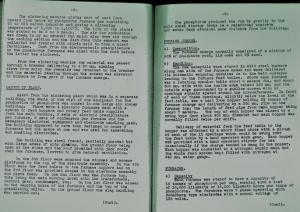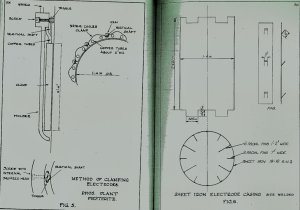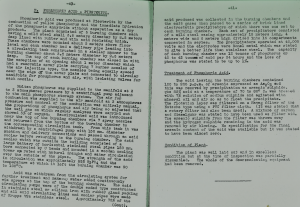To the victors the spoils- that is the true fortune that can be made from war. At the end of the second world war, the so called “allies” who were not allied for long ransacked Germany looking for anything that could be found of future interest. Rockets and germ warfare were the most sort after Nazi artefacts that “the allies” would spend the next 50 years competing against one another in the laboratory fields of war, but German science in general at this point in history was heavily studied. A particularly interesting document is one which I have obtained and reproduced in full scans below.
It is a British Intelligence sub- committee report no 562 into a tour of two German phosphorus industry factories at Bitterfeld and Piesteritz. It is dated from 1946 when a party of operatives from The ministry of supply visited the area held by Russian forces between March 12th-April 3rd. The two factories appear to have been given the codenames 221b (I.G Farben ,Bitterfeld), and C22/3437 Bayerrische Stickstoffe AG, Piesteritz.)
It deals with the production of white phosphorus, from which we learn that the factories toured were the only ones producing the chemical weapon in the Reichland. Therefore any incendiary bombs falling on civilians during raids in Britain, and weapons killing British forces would have been produced at these factories. There are also detailed reports into the production of Red phosphorus, phosphorus sesquisulphide, phosphorus chlorides and phosphoric acid. All of these would become commercially and financially important to Albright and Wilson in Britain and abroad following the end of hostilities. Albright and Wilson, you may recall were the only UK producers of white phosphorus during WW2, and so it would be interesting to those touring the factory with an insight into the former, as to what their opposite numbers had concocted.
We learn that the Bitterfeld plant only produced 3% of WP during the war with the main operation being at Piesteritz.
One of the most interesting aspects of this report comes in the revelation of special safety and health precautions.
“The compounds Phosphorus Trichloride, pentachloride and oxychloride affect the mucous membranes, particularly of the eyes, the bronchoial tubes and the lungs. Where the vapour of the products can escape there are provided goggles and respirators…
The Manufacture is under medical supervision which takes place monthly. This involves particularly examination of the teeth and medical treatment is carried by the manufacturer, thus tooth brushes and dental treatment are provided free of charge.
Workers’s baths are arranged daily at the end of the shift and soap and towels are provided. There are also provided without charge, working clothing, shoes with wodden soles and gloves. During the war the employees were provided with heavy workers rations.”
If all this is sounding rather familiar with the way in which Albright and Wilson would openly boast about providing similar for its workers post war, it is perhaps not that surprising given the name of the man in charge of the tour on behalf of the ministry of supply- one Alfred H. Loveless– chief engineer of Albright and Wilson!
Conveniently the document makes no comparisons between the state of the German phosphorus machine and their capabilities compared to that which had been operating at Trinity Street. We also cannot determine what Loveless and his colleagues took back with them except the detailed drawings and insights into a rivals work, but oh what a gift it must have been for Loveless to wander into a factory where he and the company he worked for could be provided with future ideas, patents and technology which The British company could steal for their own. It would be very naïve to paint this as supposition, as what had he really been invited there for under direction of the British Government?
These Nazi works, having killed thousands of soldiers and British civilians being exploited commercially by a so called “Quaker company”- the reality of this cult perhaps can now be seen for what it truly is- a giant falsity of profiting directly from war- so long as you are on the winning side to see it. But it is also one which operated hand in hand with the British establishment and particularly its military machine. Whilst all talking loudly about “PEACE, they whispered “war” in laboratory asides.
Loveless is mentioned on a few occasions within 100 years of phosphorus making by Richard Threlfall, the centenary history of the Oldbury Company, though he does not of course reveal in this book written only 5 years after the tour of the German factory as to how Albright and Wilson potentially directly gained from the Nazi’s post war. He is instead more interested in tails of dering do involving how Loveless and others made AW bombs containing white phosphorus and other weapons a reality. Of course we now know how useless these were, but effective in killing grazing animals and poisoning the environment for decades to come.
Loveless also appears to have written other papers for BIOS as field team leader including German production of potassium permanganate at Bitterfeld and sodium sulphide at Wolfen, but he would later become a director of the Albright and Wilson PLC company and further into the future a player in the disastrous Long Harbour venture, where his engineering expertise would not be so wonderfully executed.
The two sites visited would soon fall under the iron curtain of East Germany, later to be reunified but still a centre of German chemical industry. Bitterfeld today appears to have undergone a similar parallel fate to that of Oldbury, except the latter has yet to see any real transformation. It is now in the grip of Bayer, who of course happen to be a close chemical European partner of Solvay- so you could say they all owe something to the Nazi chemical enterprise.
The boons for Albright and Wilson from Loveless seeing how other derivatives of phosphorus were produced in Germany by Britain’s main rival cannot be underestimated given how Oldbury changed its entire operations at Trinity Street after the war. How much of what Loveless saw in Germany and how much inspiration he ripped off from it to profit Albright and Wilson may be called “speculation”, but it is something that fans of this company would no doubt like to see buried. It is also something which their workers could also be said to have been fooled into believing that this technology was something “made in Britain”. Could it be that the manufacturing of white phosphorus and its derivatives at Oldbury in the latter part of the 20th Century should be rewritten “Made in Britain, inspired by Nazi’s”?
I have scanned the main contents of the report below, but there is an interesting appendix detailing individual components of the phosphorus furnace and machinery which together with the detailed diagrams could offer a DIY guide in how to build a phosphorus war machine. Written in German, the inventory may well make an interesting collect and build publication in the form of one of those “free binder with part one” titles where you can construct something large out of smaller parts, but I’ll save that one for a future post when I’ve done a bit of translation and had a go at building one myself, out of matchsticks of course 😆 😆



































